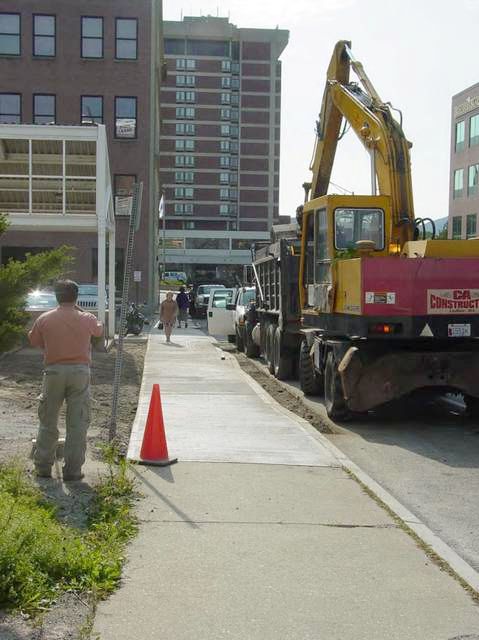Burning the Midnight Oil for a Brawny Recovery
Joseph Stiglitz on the Political Economy of the Bail-Out: Who’s At the Table?
Or as your humble correspondent wrote at Obama’s Emergency Banking Act of 2009 (European Tribune) … (below the fold)

Feb 14 2009
Burning the Midnight Oil for a Brawny Recovery
Joseph Stiglitz on the Political Economy of the Bail-Out: Who’s At the Table?
Or as your humble correspondent wrote at Obama’s Emergency Banking Act of 2009 (European Tribune) … (below the fold)
Feb 09 2009
Burning the Midnight Oil for the Next American Revolution
 Jerome a Paris at the European Tribune focuses in on the central problem of the Financial crisis, and therefore the central problem of the Bail-Out:
Jerome a Paris at the European Tribune focuses in on the central problem of the Financial crisis, and therefore the central problem of the Bail-Out:
But, pontificating aside, the reality is that we had a large scale grand robbery of the past few years. To make it simple: the Fed printed money, gave it for free to rich people, who lent it to poor people at at nice profit instead of paying them wages; reimbursement was possible only if house prices went up, and that lasted for a while. The rich made out like bandits on their assets, financial or otherwise, and the poor thought they were more or less keeping up with the Joneses (the reality was a large-scale transfer of wealth from one group to the other, no bonus points for guessing which was which). Now that it’s no longer the case, the poor lose their house, stop paying their debt at some point, put the banks in a pickles, and the economy unravels. Except that the banks are being bailed out, which means, fundamentally, saving the owners of financial assets (bank bondholders specifically, and bond holders in general) at the expense of taxpayers, thus having the goverment validate and consolidate the past transfer of wealth.
 So leverage is the central problem … or rather, the central problems:
So leverage is the central problem … or rather, the central problems:
Jan 26 2009
Adapted from an entry at Burning the Midnight Oil for Living Energy Independence … links to crossposts may be found there.
 OK, so, to make an egregiously long story merely excessively long, a very strange thing happened on the road to the Stimulus Package. As Rep. Oberstar told the U.S. Conference of Mayors:
OK, so, to make an egregiously long story merely excessively long, a very strange thing happened on the road to the Stimulus Package. As Rep. Oberstar told the U.S. Conference of Mayors:
That is why we set forth this $85-billion initiative from our committee. It’s been reduced in the final going. We expect that it’ll come out somewhere around $63 billion, but $30 billion for highways.
The reason for the reduction in overall funding … was the tax cut initiative that had to be paid for in some way by keeping the entire package in the range of $850 billion.
As I described in Transport Stimulus: You’re Doing It Wrong, actual effective stimulus spending was shortchanged — and in particular spending with substantial long term economic and strategic benefits — to “pay for” tax cuts.
In reality, if we want to be able to “afford” tax cuts, what we need first and foremost is growth, and economic growth requires effective government investment in the infrastructure of a New Energy Economy.
Jan 18 2009
Burning the Midnight Oil for Energy Independence (crosspost links at the blog)
There is this big emphasis on “shovel ready projects” in the Stimulus Bill … but now that the details are coming out, we can see that in transport, its just a load of horseshit used as an excuse for supporting business as usual.

The headline numbers are $30b highway spending, $10b for public transport and rail:
I got a “shovel-ready” project for you … shoveling out the bullshit from the Bush Administration Department of Transport and replacing the pandering to the oil companies with a concern for America’s Economic Future.
Jan 04 2009
Burning the Midnight Oil to Drag Economics into the Real World
 As Jerome a Paris has noted, among others, Paulson and others of his ilk have started blaming the Chinese and Germans for our economic woes:
As Jerome a Paris has noted, among others, Paulson and others of his ilk have started blaming the Chinese and Germans for our economic woes:
The US Treasury Secretary said that in the years leading up to the crisis, super-abundant savings from fast-growing emerging nations such as China and oil exporters – at a time of low inflation and booming trade and capital flows – put downward pressure on yields and risk spreads everywhere.
This, he said, laid the seeds of a global credit bubble that extended far beyond the US sub-prime mortgage market and has now burst with devastating consequences worldwide.
What a sorry load of … well, let me go for a better analogy than that … and then dig more deeply into the whys and wherefores of its load of …
… uh, after the fold.
Dec 23 2008
Burning the Midnight Oil for Living Energy Independence and My Left Wing
Twin Cities Streets for People present The Future (result) of Freeway Expansion:
A little bit optimistic and a little bit pessimistic at one and the same time, I’d say … but, they really do have a very solid point.
Follow me over the fold for talks of an Exurban Cycle Commuter, and reflections on the risk of a Road Widening Stimulus Package.
Nov 21 2008
Burning the Midnight Oil for Real World Economics
NB. New Oil links are now located at the Midnight Oil Blog
 A while ago, as an off-shoot of the Beauty Platform, I set out a Beautiful Bail-Out plan.
A while ago, as an off-shoot of the Beauty Platform, I set out a Beautiful Bail-Out plan.
Two key parts were: 50:50 on money going to help regular home buyers to extricate themselves from the mortgage meltdown, and on bailing out the finance sector from the mess they got themselves into …
… and having the finance sector bail out consisting of both unloading dubious assets and issue of Senior Preferred shares with heavy strings attached.
Now, the Administration did not, in fact, listen to me, but when Senator Dodd was complaining about what banks had done with their bail out money, waddya know … I got a perfect three out of three on what strings needed to be attached to the money:
… until the Senior Preferred Dividend had been paid for four quarters straight … and kicking back in if the firm in the future ran into problems meeting the Senior Preferred Dividend.
But … does the Beautiful Bail Out model extend to the Big Three?
Oct 05 2008
 Here at Docudharma yesterday’s diary on The Magic of Default Swaps: You Too can be an Insurance Company, cassiodorus says:
Here at Docudharma yesterday’s diary on The Magic of Default Swaps: You Too can be an Insurance Company, cassiodorus says:
Dollar hegemony, however, can only prevent a general contagion of dollars up to a point. What that point is, however, is a mystery. … Thus hyperinflation and currency crash.
As I see it, there are two paths ahead.
(1) A crash program of investment in sustainable energy production and energy efficiency in transport, housing and farming, leveraging the exporters-exchange-rate the US$ will be seeing into a central position in the growth industries of the 21st century … or …
(2) We try to continue on the same unsustainable course, and have a hyperinflation.
Background, more detail and analysis beyond the fold.
Oct 05 2008
The numbers that are thrown around are so mind-boggling that they are mind-numbing. The total amount of Credit Default Swap (CDS) obligations outstanding, according to the Bank of International Settlement, was 57 trillion US$ in December 2007 (pdf).
That is roughly Four Times the size of the US GDP.
These are the things that Warren Buffet called a “time bomb”.
What are they? Well, suppose that we are watching a little old lady crossing a street, and want to take out a life insurance policy that pays if she gets clobbered by traffic. Unless she is close family, or she is a business partner, we can’t do that … we have no insurable interest.
But if we were watching a company, and wanted to buy a contract that pays off if the company can’t pay on its bonds, we could. We’d buy a CDS.
Oct 01 2008
 So, Monday a bail-out package described by opponents a excrement on toast went down to defeat because after getting compromises to make it, in my view, worse, the Republican leadership could not then deliver enough Republican votes to get the thing passed “on a bipartisan basis”.
So, Monday a bail-out package described by opponents a excrement on toast went down to defeat because after getting compromises to make it, in my view, worse, the Republican leadership could not then deliver enough Republican votes to get the thing passed “on a bipartisan basis”.
Like they are unwilling to take unpopular votes to protect business interests? What was more than a decade of votes against the Minimum Wage about, then?
So, the first step is to see if the non-finance sector business lobby has been on the phone with the Rebel Replicants, cursing them a blue streak for screwing the pooch so badly before the Christmas shopping season. Perhaps they are, and so perhaps they will toe the line.
And if not, then the Democrats can turn to putting together a Beautiful Financial Rescue Package that the caucus can support. So, what would that look like?
Sep 27 2008
 OK, now, Wash-Mooooo has been taken to the slaughterhouse and the choicest cuts bought by JP Morgan Chase (full disclosure: I bank at Chase).
OK, now, Wash-Mooooo has been taken to the slaughterhouse and the choicest cuts bought by JP Morgan Chase (full disclosure: I bank at Chase).
Didn’t anyone know that this was going on? Well, of course people did. For example, back in May of this year, William C. Dudley, an Executive VP at the New York Federal Reserve Bank said:
So what has been driving the recent widening in term funding spreads? In my view, the rise in funding pressures is mainly the consequence of increased balance sheet pressure on banks.
And, obviously, “balance sheet pressure” is a nice way of saying trending toward a risk of insolvency.
Of course, the Fed has been acting for a year now like we are facing a liquidity crisis, when we are actually facing a solvency crisis … but if you carefully read an analysis by a fairly senior person in the Federal Reserve System, its all there. What’s up?
Join me below the fold.